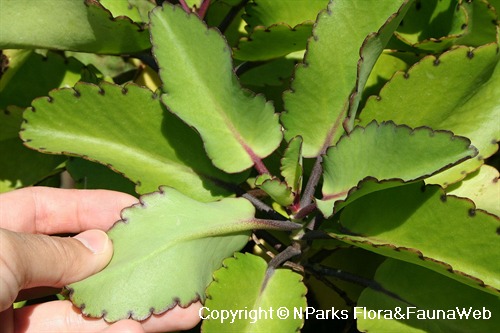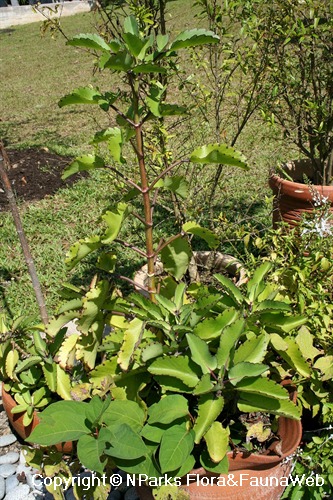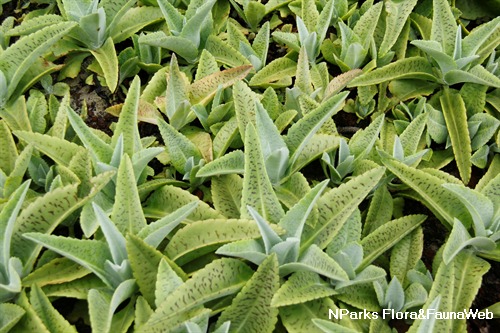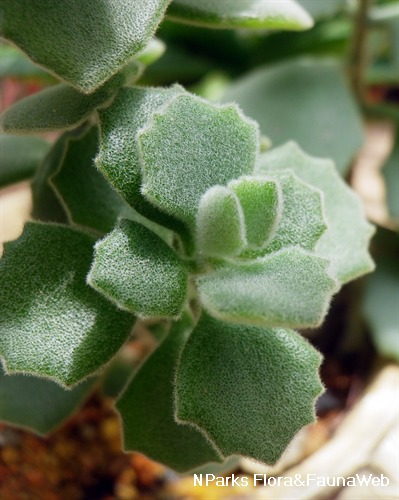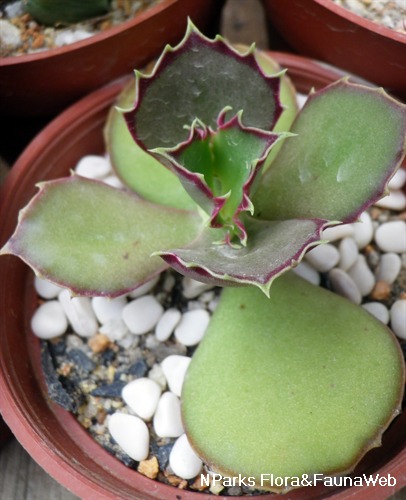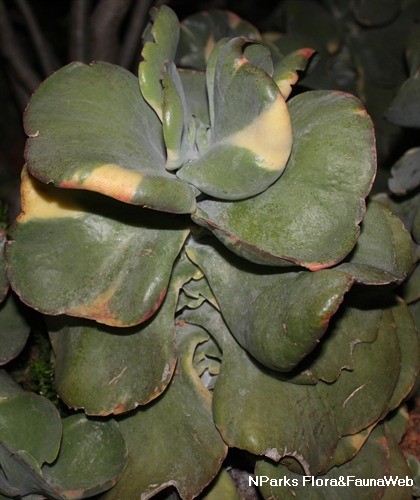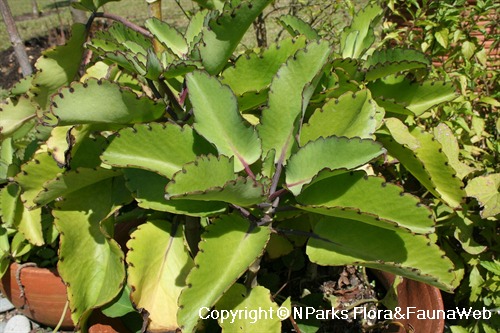
Back
Kalanchoe pinnata (Lam.) Pers.
| Family Name: | Crassulaceae |
| Synonyms: | Bryophyllum calycinum, Crassula pinnata, Cotyledon pinnata, Bryophyllum pinnatum |
| Common Name: | Life Plant, Mother of Thousands, Miracle Leaf, Setawar Kampung, 落地生根 |
Name
Classifications and Characteristics
| Plant Division | Angiosperms (Flowering Seed Plants) (Dicotyledon) |
|---|---|
| Plant Growth Form | Herbaceous Plant |
| Lifespan (in Singapore) | Perennial |
| Mode of Nutrition | Autotrophic |
| Plant Shape | Shrubby |
| Maximum Height | 0.9 m to 1.8 m |
Biogeography
| Native Distribution | Madagascar |
|---|---|
| Preferred Climate Zone | Sub-Tropical / Monsoonal |
Description and Ethnobotany
| Growth Form | Herbaceous succulent shrub, up to 1.8m height. |
|---|---|
| Foliage | Leaves smooth, glossy, fleshy, with brownish crenate margins, from which plant produces new plantlets. Lower leaves simple, upper leaves compound with 3-7 leaflets held on long petioles. |
| Flowers | Attractive, bell-shaped, pendulous, held in large stalked panicles. |
| Fruit | Membranous follicles covered by persistent flower parts, with numerous seeds. |
| Associated Fauna | Host plant for caterpillars of Talycada nyseus (Red Pierrot) butterfly. Caterpillars tunnel through inner leaf tissues, leaving epidermis intact, resulting in translucent or water-soaked patches on leaves. |
| Cultivation | Prefers well-drained soils. Propagate by stem cuttings or leaf plantlets. Plantlets are easily produced from fallen leaves, and may become weedy. |
| Etymology | Genus epithet 'Kalanchoe' (correctly pronounced as kal-un-KOH-ee) reportedly derived from Chinese dialect name for a species in this genus (perhaps Kalanchoe ceratophylla) . Species epithet 'pinnata' means 'feather-like', describing how the leaves are arranged on each side of a common stalk. |
| Ethnobotanical Uses | Edible Plant Parts : Edible Leaves Food (Herb or Spice) Others: Medicinal: Well-known for healing properties in folk medicine, said to be able to heal wounds with minimal scarring. Leaf pulp applied topically as poultices for skin lesions, sores, inflammation and to arrest bleeding, or made into lotions to treat smallpox. Leaf paste applied to chest to relieve coughs, or to temples to relieve headaches. Eaten fresh or dried to treat symptoms of diarhhoea, dysentery, chlorea, and dissolve kidney stones. Cultural: Stems and leaves sometimes hung in houses to summon good spirits & ward off evil ones. Leaves also commonly placed in between pages of book as living bookmarks. |
Landscaping Features
| Landscape Uses | Interiorscape/ Indoor Plant, General, Suitable for Rooftops, Container Planting |
|---|---|
| Thematic Landscaping | Rockery / Desert Garden, Economic Garden, Naturalistic Garden |
| Usage Hazard - Cons | Toxic Upon Ingestion |
| Usage Hazard - Cons Remarks | Can cause cardiac poisoning in grazing animals. |
Fauna, Pollination and Dispersal
| Fauna Pollination Dispersal Associated Fauna | Butterfly Host Plant |
|---|---|
| Seed or Spore Dispersal | Abiotic (Explosive Dehiscence) |
Plant Care and Propagation
| Light Preference | Full Sun, Semi-Shade |
|---|---|
| Water Preference | Little Water |
| Plant Growth Rate | Fast |
| Rootzone Tolerance | Easy to Grow, Drought Tolerant, Well-Drained Soils, Disease / Pest Resistant, Shallow Media |
| Maintenance Requirements | Moderate |
| Potential Problems | New plantlets grow very easily from edges of fallen leaves. May become weedy or a nuisance. |
| Diseases | Plant may suffer root rot If grown in poorly-drained soils. |
| Propagation Method | Stem Cutting, Leaf Cutting, Air-Layering |
Foliar
| Foliage Retention | Evergreen |
|---|---|
| Mature Foliage Colour(s) | Brown, Green |
| Mature Foliage Texture(s) | Smooth, Glossy / Shiny, Thick |
| Foliar Type | Simple / Unifoliate |
| Foliar Arrangement Along Stem | Opposite, Spiral |
| Foliar Venation | Pinnate / Net |
| Foliar Margin | Crenate |
| Typical Foliar Area | Notophyll ( 20.25cm2 - 45 cm2 ) |
| Leaf Area Index (LAI) for Green Plot Ratio | 4.5 (Shrub & Groundcover - Dicot) |
Non - Foliar and Storage
| Stem Type & Modification | Herbaceous |
|---|---|
| Root Type | Underground (Fibrous Root) |
| Specialised Storage Organ(s) | Aboveground |
Floral (Angiosperm)
| Flower & Plant Sexuality | Bisexual Flowers |
| Flower Colour(s) | Cream / Off-White, Pink, Red |
|---|---|
| Inflorescence Type | Panicle |
| Ovary Position | Superior / Hypogynous |
| Flowering Habit | Polycarpic |
Fruit, Seed and Spore
| Fruit Classification | Simple Fruit |
|---|---|
| Fruit Type | Dehiscent Dry Fruit , Follicle |
Image Repository
Others
| Master ID | 13139 |
|---|---|
| Species ID | 3323 |
| Flora Disclaimer | The information in this website has been compiled from reliable sources, such as reference works on medicinal plants. It is not a substitute for medical advice or treatment and NParks does not purport to provide any medical advice. Readers should always consult his/her physician before using or consuming a plant for medicinal purposes. |

